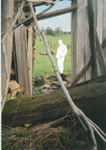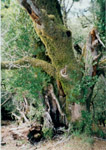Now for some quick observations.
The Northern Mariposa County History Center (located on the northwest corner of 132 and 49 in Coulterville) has an amazing historically accurate scale model of a local hotel. The builder spent 4000 hours constructing it and the scale is probably close to 1 inch = 1.5 feet (could be way off on this - basically, it's a very large model, at least twenty square feet of footprint). The craftsmanship is amazing. Every interior room is decorated: the attached stores have fully stocked shelves, all the tables in the dining room are set, the staircase is beautiful. The rest of the museum is cool but that model was the centerpiece by far. Every single component, with the exception of the rails on the balcony railing (is that what you call the vertical components of a railing?), was scratch built. The docent told us that the builder initially wanted to do a smaller sized model but the size-determining-factor was related to the balcony rails - he made the decision not to hand turn close to a hundred of those so he bought them. The scale of the project was dictated by the size of rails he found. I'm glad he couldn't find smaller rails. It's an absolutely phenomenal piece of work. (Note: All estimates are subject to large margins of error since I was so impressed with the gestalt that the actual details got lost in the shuffle).
The whole reason for going to the History Center was because I'd read on-line that they sold "The Big Oak Flat Road to Yosemite" by Margaret Schlichtmann and Irene Paden. I was hoping to find some information on the stage line from Copperopolis to Sonora in the book. They did have a couple of copies of the book. It was shrink-wrapped in plastic so I couldn't browse. I am now the owner of said book. It has none of the information I was looking for. Oh well. It still looks like a fascinating read.
I also got another reading tip from the docent, "Bacon & Beans from a Gold Pan" by George Hoeper as told by Jesse Coffey ("an unusual true-life adventure of a young couple who camped in the mountains of California to make a living panning for gold" - from the front cover). According to the docent (and why didn't I ask for her name?) this is a story of a couple who moved east from San Francisco during the depression to squat on the land and try to survive by prospecting. She has been trying to get that book for the history center but hasn't been successful - it is available through the Tuolumne County Visitors Bureau website (cross-county rivalry apparently).
And that was just the first stop.
A couple of things more to relate while they're fresh.
As I was driving up and down O'Byrne's Ferry Road, looking for some way to head east and getting stymied time after time by gates and "No Trespassing" signs impeding access to promising looking dirt roads, I couldn't help think of one of the forgotten verses of Woody Guthrie's classic:
Was a high wall there that tried to stop meUnfortunately, I didn't follow Woody's example.
A sign was painted said: Private Property,
But on the back side it didn’t say nothing —
This land was made for you and me
S. having our emergency cel phone was a good idea. I still dislike the philosophy behind cel phones in general. In this one instance, it simplified our lives. It was for situations like this - trying to meet up in a town neither of us have visited in 6 years after two and a half hours - that we decided to get the dang thing. Now let's hope we never have to use it again. (On a side note, the reception sucked. It took a minute of me screaming into a gas station pay phone the alternating words, "Mocha" and "Coffee" before S. was finally able to hear that I was hoping she'd have some caffeine waiting for me when I picked her up. Alas, all stores that sell the nectar of the marvelous bean were closed and the only result was that patrons of that particular gas station now think I'm a raving lunatic).
The iPod to car tape-deck adaptor simply ROCKS! From Oakdale until we got home we were treated to The Cars, Queen, and The Ramones absodamnlutely commercial free.
More tomorrow, I'm spent.



















